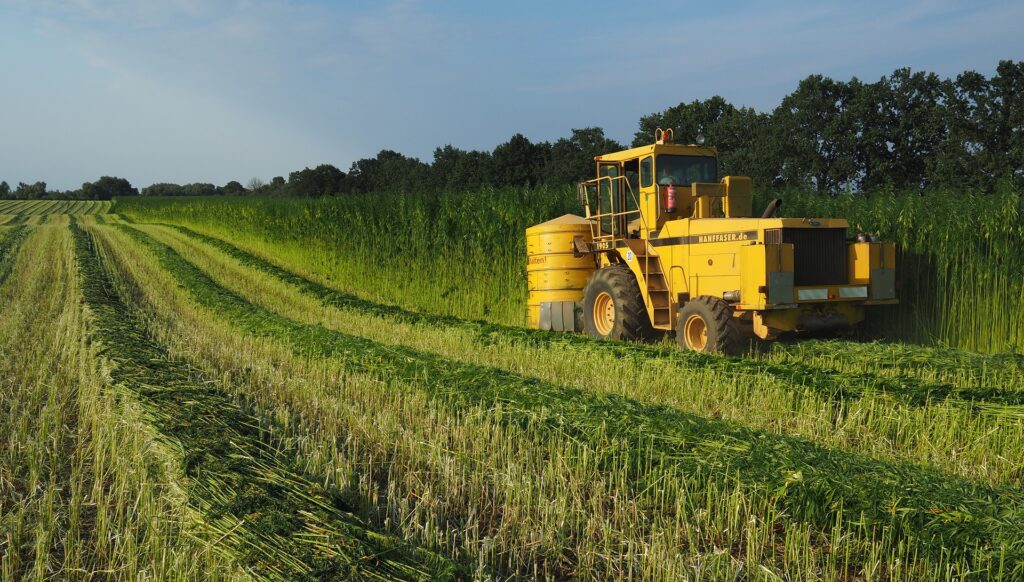Water consumption of industrial hemp (Cannabis sativa L.) from a site in northern Kazakhstan
Niels Thevs a,b*, Kumar Aliev a
a Central Asia Office, CIFOR-ICRAF, Toktogul Street 141, 720001 Bishkek, Kyrgyzstan
b Gesellschaft für Internationale Zusammenarbeit (GIZ), Friedrich-Ebert-Allee 32+36, 53113 Bonn, Germany
*Corresponding author e-mail: N.Thevs@cgiar.org
Kumar Aliev e-mail: k.aliev@cgiar.org
https://doi.org/10.29258/CAJWR/2022-R1.v8-2/19-30.engResearch article

Abstract
Purpose: This study investigated the water consumption (crop evapotranspiration) of industrial hemp on a newly established hemp field in Aqmola Region of Northern Kazakhstan. Methodology: The water consumption of hemp was investigated through direct measurements of the sapflow movement during the second half of the growing season 2021. These sapflow data yielded data on the water consumption. The water consumption of the first part of the growing season was assessed through the Penman-Monteith approach by FAO. Findings: The water consumption of hemp was 353 mm over the growing season at a stem yield of 10 t/ha. Under the water supply conditions of the study site, hemp offers higher yields than grasslands or grains. Originality/value: This is the first study that revealed data on water consumption of hemp for the region Central Asia as a potential raw material plant for bioeconomy.
Available in English
Download the article (eng)For citation: Thevs, N., Aliev, K. (2022).Water consumption of industrial hemp (Cannabis sativa L.) from a site in northern Kazakhstan. Central Asian Journal of Water Research, 8(2), 19–30. https://doi.org/10.29258/CAJWR/2022-R1.v8-2/19-30.eng
References
Allen, R.G., Pereira, L.S., Raes, D. & Smith, M. (1998). Crop evapotranspiration – Guidelines for computing crop water requirements. FAO Irrigation and drainage paper 56. Rome: FAO.
Amaducci, S. & Gusovius, H. J. (2010). Hemp-cultivation, extraction and processing. In J. Müssig (Ed.). Industrial Applications of Natural Fibres: Structure, Properties and Technical Applications (pp. 109–134). West Sussex: John Wiley Sons Ltd.
Babaei, M. & Ajdanian, L. (2020). Screening of different Iranian ecotypes of cannabis under water deficit stress. Scientia Horticulturae, 260, 108904. https://doi.org/10.1016/j.scienta.2019.108904.
Baier, C., Thevs, N., Villwock, D., Emileva, B. & Fischer, S. (2021). Water Productivity of Paulownia Tomentosa × Fortunei (Shan Tong) in a Plantation at Lake Issyk-Kul, Kyrgyzstan, Central Asia. Trees. https://doi.org/10.1007/s00468-021-02141-8.
CACILM and ADB (Central Asian Countries Initiative for Land Management and Asian Development Bank) (2010). Central Asia Atlas of Natural Resources. Manila, Philippines: CACILM and ADB. http://www.adb.org/sites/default/files/publication/27508/central-asia-atlas.pdf.
Clearwater, M.J., Meinzer, F.C., Andrade, J.L., Goldstein, G. & Holbrook, N.M. (1999). Potential errors in measurement of nonuniform sap flow using heat dissipation probes. Tree physiology, 19, 681–687. https://doi.org/10.1093/treephys/19.10.681.
Climate data. (2021) https://de.climate-data.org [In German]
Consentino, S.L., Riggi, E., Testa, G., Scordia, D. & Copani, V. (2013). Evaluation of European developed fibre hemp genotypes (Cannabis sativa L.) in semi-arid Mediterranean environment. Industrial Crops and Products, 50, 312-324. http://dx.doi.org/10.1016/j.indcrop.2013.07.059.
Eisfelder, C., Klein, I., Niklaus, M. & Kuenzer, C. (2014). Net primary productivity in Kazakhstan, its spatio-temporal patterns and relation to meteorological variables. Journal of Arid Environments, 103, 17-30. https://doi.org/10.1016/j.jaridenv.2013.12.005.
Flo, V., Martinez-Vilalta, J., Steppe, K., Schuldt, B. & Poyatos, R. (2019). A synthesis of bias and uncertainty in sap flow methods. Agricultural and Forest Meteorology, 271, 362-374. https://doi.org/10.1016/j.agrformet.2019.03.012.
García-Tejero, I.F., Durán-Zuazo, V.H., Pérez-Álvarez, R., Hernández, A., Casano, S., Morón, M. & Muriel-Fernández, J.L. (2014). Impact of Plant Density and Irrigation on Yield of Hemp (Cannabis sativa L.) in a Mediterranean Semi-arid Environment. Journal of Agriculture, Science, and Technology, 16, 887-895.
Granier, A. (1985). Une nouvelle méthode pour la mesure du flux de sève brute dans le tronc des arbres. Annales des Sciences forestières EDP Sciences, 42-2, 193-200.
Ingrao, C., Bacenetti, J., Bezama, A., Blok, V., Goglio, P., Koukios, E.G., Lindner, M.,
Nemecek, T., Siracusa, V., Zabaniotou, A. & Huisingh, D. (2018). The potential roles of bio-economy in the transition to equitable, sustainable, post fossil-carbon societies: Findings from this virtual special issue. Journal of Cleaner Production, 204, 471–488. https://doi.org/10.1016/j.jclepro.2018.09.068.
Kusainova, A.A., Mezentseva, O.V. & Tusupbekov, Z.A. (2020). Influence of precipitation variability and temperature conditions on the yield of grain crops in Northern Kazakhstan. IOP Conf. Series: Earth and Environmental Science, 548, 042026. doi:10.1088/1755-1315/548/4/042026.
Lisson, S. & Mendham, N. (1998). Response of fiber hemp (Cannabis sativa L.) to varying irrigation regimes. Journal of the International Hemp Association, 5(1), 9-15.
Moscariello, C., Matassa, S., Esposito, G. & Papirio, S. (2021). From residue to resource: The multifaceted environmental and bioeconomy potential of industrial hemp (Cannabis sativa L.). Resources, Conservation, and Recycling, 175, 105064. https://doi.org/10.1016/j.resconrec.2021.105864.
Noghabi, S.G., Shahidi, A. & Homami, H. (2021). Estimation of Water Requirement and Crop Coefficient for Hemp at Different Growth Stages in Birjand Plain. Journal of Water Research in Agriculture. DOI: 10.22092/jwra.2021.122794.
Oishi, A.C., Hawthorne, D.A. & Oren, R. (2016). Baseliner: An open-source, interactive tool for processing sap flux data from thermal dissipation probes. SoftwareX, 5, 139–143. https://doi. org/10.1016/j.softx.2016.07.003.
Reliable prognosis. (2021) www.rp5.ru
Reyer, C.P.O., Otto, I.M., Adams, S., Albrecht, T., Baarsch, F., Cartsburg, M., Eden, A., Ludi, E., Marcus, R., Mengel, M., Mosello, B., Robinson, A., Schleussner, C.-F., Serdeczny, O. & Stagl, J. (2017). Climate change impacts in Central Asia and their implications for development. Regional Environmental Change. doi 10.1007/s10113-015-0893-z.
Smith, D.M. & Allen, S.J. (1996). Measurement of sap flow in plant stems. Journal of Experimental Botany, 47, 1833–1844. https://doi.org/10.1093/jxb/47.12.1833
Strenge, E., Thevs, N., Aliev, K., Eraaliev, M., Lang, P. & Baibagysov, A. (2018). Water consumption of Populus alba trees in tree shelterbelt systems in Central Asia. Central Asian Journal for Water Resources, 4, 48-62. https://www.water-ca.org/api/v1/articles/5955-water-consumption-of[1]populus-alba-trees-in-tree-shelterbelt-systems-in-central-asia.pdf.
Struik, P. C., Amaducci, S., Bullard, M. J., Stutterheim, N. C., Venturi, G., & Cromack, H. T. H. (2000). Agronomy of fibre hemp (Cannabis sativa L.) in Europe. Ind. Crops Prod, 11, 107–118. doi: 10.1016/S0926-6690(99)00048-5.
Thevs, N., Gombert, A.J., Strenge, E., Lleshi, R., Aliev, K. & Emileva, B. (2019). Tree wind breaks in Central Asia and their effects on agricultural water consumption. Land, 8, 167 – 183. https://doi. org/10.3390/land8110167
bioeconomy, biomass, Central Asia, evapotranspiration, textile plant